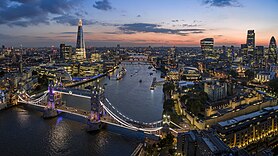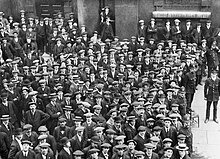
A | B | C | D | E | F | G | H | CH | I | J | K | L | M | N | O | P | Q | R | S | T | U | V | W | X | Y | Z | 0 | 1 | 2 | 3 | 4 | 5 | 6 | 7 | 8 | 9
London is the capital and largest city of England, and the United Kingdom, with a population of around 8.8 million,[1] and its metropolitan area is the largest in Western Europe, with a population of 14.8 million.[9][note 1] It stands on the River Thames in south-east England at the head of a 50-mile (80 km) estuary down to the North Sea and has been a major settlement for nearly two millennia.[10] The City of London, its ancient core and financial centre, was founded by the Romans as Londinium and retains its medieval boundaries.[note 2][11] The City of Westminster, to the west of the City of London, has for centuries hosted the national government and parliament. In the 19th century, London grew rapidly, becoming the world's largest city at the time, as it expanded and absorbed the neighbouring county of Middlesex, and parts of Surrey and Kent. In 1965 it was combined with parts of Essex and Hertfordshire[12] to create the administrative area of Greater London,[13] which is governed by 33 local authorities and the Greater London Authority.[note 3][14]
As one of the world's major global cities,[15][16] London exerts a strong influence on world art, entertainment, fashion, commerce and finance, education, health care, media, science and technology, tourism, transport, and communications.[17][18] Despite a post-Brexit exodus of stock listings from the London Stock Exchange,[19] London is still Europe's most economically powerful city,[20] and it remains one of the major financial centres in the world. With Europe's largest concentration of higher education institutions,[21] it is home to some of the highest-ranked academic institutions in the world—Imperial College London in natural and applied sciences, the London School of Economics in social sciences, and the comprehensive University College London.[22][23] London is the most visited city in Europe and has the busiest city airport system in the world.[24] The London Underground is the oldest rapid transit system in the world.[25]
London's diverse cultures encompass over 300 languages.[26] The 2023 population of Greater London of just under 10 million[27] made it Europe's third-most populous city,[28] accounting for 13.4% of the population of the United Kingdom[29] and over 16% of the population of England. The Greater London Built-up Area is the fourth-most populous in Europe, with about 9.8 million inhabitants at the 2011 census.[30][31] The London metropolitan area is the third-most populous in Europe, with about 14 million inhabitants in 2016,[note 4][32][33] granting London the status of a megacity.
London has four World Heritage Sites: the Tower of London; Kew Gardens; the combined Palace of Westminster, Westminster Abbey, and St Margaret's Church; and the historic settlement in Greenwich, where the Royal Observatory, Greenwich, defines the prime meridian (0° longitude) and Greenwich Mean Time.[34] Other landmarks include Buckingham Palace, the London Eye, Piccadilly Circus, St Paul's Cathedral, Tower Bridge, and Trafalgar Square. London has many museums, galleries, libraries, and cultural venues, including the British Museum, National Gallery, Natural History Museum, Tate Modern, British Library, and numerous West End theatres.[35] Important sporting events held in London include the FA Cup Final, the Wimbledon Tennis Championships, and the London Marathon. In 2012, London became the first city to host three Summer Olympic Games.[36]
Toponymy
London is an ancient name, attested in the first century AD, usually in the Latinised form Londinium.[37] Modern scientific analyses of the name must account for the origins of the different forms found in early sources: Latin (usually Londinium), Old English (usually Lunden), and Welsh (usually Llundein), with reference to the known developments over time of sounds in those different languages. It is agreed that the name came into these languages from Common Brythonic; recent work tends to reconstruct the lost Celtic form of the name as *Londonjon or something similar. This was adapted into Latin as Londinium and borrowed into Old English.[38]
Until 1889, the name "London" applied officially only to the City of London, but since then it has also referred to the County of London and to Greater London.[39]
History
Prehistory
In 1993, remains of a Bronze Age bridge were found on the south foreshore upstream from Vauxhall Bridge.[40] Two of the timbers were radiocarbon dated to 1750–1285 BC.[40] In 2010, foundations of a large timber structure, dated to 4800–4500 BC,[41] were found on the Thames's south foreshore downstream from Vauxhall Bridge.[42] Both structures are on the south bank of the Thames, where the now-underground River Effra flows into the Thames.[42]
Roman London

Despite the evidence of scattered Brythonic settlements in the area, the first major settlement was founded by the Romans around 47 AD,[2] about four years after their invasion of 43 AD.[43] This only lasted until about 61 AD, when the Iceni tribe led by Queen Boudica stormed it and burnt it to the ground.[44]
The next planned incarnation of Londinium prospered, superseding Colchester as the principal city of the Roman province of Britannia in 100. At its height in the 2nd century, Roman London had a population of about 60,000.[45]
Anglo-Saxon and Viking-period London
With the early 5th-century collapse of Roman rule, the walled city of Londinium was effectively abandoned, although Roman civilisation continued around St Martin-in-the-Fields until about 450.[46] From about 500, an Anglo-Saxon settlement known as Lundenwic developed slightly west of the old Roman city.[47] By about 680 the city had become a major port again, but there is little evidence of large-scale production. From the 820s repeated Viking assaults brought decline. Three are recorded; those in 851 and 886 succeeded, while the last, in 994, was rebuffed.[48]
The Vikings applied Danelaw over much of eastern and northern England, its boundary running roughly from London to Chester as an area of political and geographical control imposed by the Viking incursions formally agreed by the Danish warlord, Guthrum and the West Saxon king Alfred the Great in 886. The Anglo-Saxon Chronicle records that Alfred "refounded" London in 886. Archaeological research shows this involved abandonment of Lundenwic and a revival of life and trade within the old Roman walls. London then grew slowly until a dramatic increase in about 950.[49]
By the 11th century, London was clearly the largest town in England. Westminster Abbey, rebuilt in Romanesque style by King Edward the Confessor, was one of the grandest churches in Europe. Winchester had been the capital of Anglo-Saxon England, but from this time London became the main forum for foreign traders and the base for defence in time of war. In the view of Frank Stenton: "It had the resources, and it was rapidly developing the dignity and the political self-consciousness appropriate to a national capital."[50]
Middle Ages

After winning the Battle of Hastings, William, Duke of Normandy was crowned King of England in newly completed Westminster Abbey on Christmas Day 1066.[51] William built the Tower of London, the first of many such in England rebuilt in stone in the south-eastern corner of the city, to intimidate the inhabitants.[52] In 1097, William II began building Westminster Hall, close by the abbey of the same name. It became the basis of a new Palace of Westminster.[53]
In the 12th century, the institutions of central government, which had hitherto followed the royal English court around the country, grew in size and sophistication and became increasingly fixed, for most purposes at Westminster, although the royal treasury came to rest in the Tower. While the City of Westminster developed into a true governmental capital, its distinct neighbour, the City of London, remained England's largest city and principal commercial centre and flourished under its own unique administration, the Corporation of London. In 1100, its population was some 18,000; by 1300 it had grown to nearly 100,000.[54] With the Black Death in the mid-14th century, London lost nearly a third of its population.[55] London was the focus of the Peasants' Revolt in 1381.[56]
London was a centre of England's Jewish population before their expulsion by Edward I in 1290. Violence against Jews occurred in 1190, when it was rumoured that the new king had ordered their massacre after they had presented themselves at his coronation.[57] In 1264 during the Second Barons' War, Simon de Montfort's rebels killed 500 Jews while attempting to seize records of debts.[58]
Early modern

During the Tudor period, the Reformation produced a gradual shift to Protestantism. Much of London property passed from church to private ownership, which accelerated trade and business in the city.[59] In 1475, the Hanseatic League set up a main trading base (kontor) of England in London, called the Stalhof or Steelyard. It remained until 1853, when the Hanseatic cities of Lübeck, Bremen and Hamburg sold the property to South Eastern Railway.[60] Woollen cloth was shipped undyed and undressed from 14th/15th century London to the nearby shores of the Low Countries.[61]
Yet English maritime enterprise hardly reached beyond the seas of north-west Europe. The commercial route to Italy and the Mediterranean was normally through Antwerp and over the Alps; any ships passing through the Strait of Gibraltar to or from England were likely to be Italian or Ragusan. The reopening of the Netherlands to English shipping in January 1565 spurred a burst of commercial activity.[62] The Royal Exchange was founded.[63] Mercantilism grew and monopoly traders such as the East India Company were founded as trade expanded to the New World. London became the main North Sea port, with migrants arriving from England and abroad. The population rose from about 50,000 in 1530 to about 225,000 in 1605.[59]
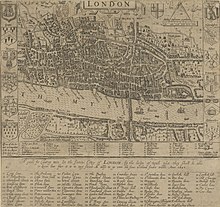
In the 16th century, William Shakespeare and his contemporaries lived in London during English Renaissance theatre. Shakespeare's Globe Theatre was constructed in 1599 in Southwark. Stage performances came to a halt in London when Puritan authorities shut down the theatres in the 1640s.[64] The ban on theatre was lifted during the Restoration in 1660, and London's oldest operating theatre, Drury Lane, opened in 1663 in what is now the West End theatre district.[65]
By the end of the Tudor period in 1603, London was still compact. There was an assassination attempt on James I in Westminster, in the Gunpowder Plot of 5 November 1605.[66] In 1637, the government of Charles I attempted to reform administration in the London area. This called for the Corporation of the city to extend its jurisdiction and administration over expanding areas around the city. Fearing an attempt by the Crown to diminish the Liberties of London, coupled with a lack of interest in administering these additional areas or concern by city guilds of having to share power, caused the Corporation's "The Great Refusal", a decision which largely continues to account for the unique governmental status of the City.[67]
In the English Civil War, the majority of Londoners supported the Parliamentary cause. After an initial advance by the Royalists in 1642, culminating in the battles of Brentford and Turnham Green, London was surrounded by a defensive perimeter wall known as the Lines of Communication. The lines were built by up to 20,000 people, and were completed in under two months.[68] The fortifications failed their only test when the New Model Army entered London in 1647,[69] and they were levelled by Parliament the same year.[70]
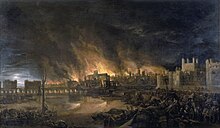
London was plagued by disease in the early 17th century,[71] culminating in the Great Plague of 1665–1666, which killed up to 100,000 people, or a fifth of the population.[71]
The Great Fire of London broke out in 1666 in Pudding Lane in the city and quickly swept through the wooden buildings.[72] Rebuilding took over ten years and was supervised by polymath Robert Hooke.[73] In 1708 Christopher Wren's masterpiece, St Paul's Cathedral, was completed. During the Georgian era, new districts such as Mayfair were formed in the west; new bridges over the Thames encouraged development in South London. In the east, the Port of London expanded downstream. London's development as an international financial centre matured for much of the 18th century.[74]
In 1762, George III acquired Buckingham House, which was enlarged over the next 75 years. During the 18th century, London was said to be dogged by crime,[75] and the Bow Street Runners were established in 1750 as a professional police force.[76] Epidemics during the 1720s and 30s saw most children born in the city die before reaching their fifth birthday.[77]
Coffee-houses became a popular place to debate ideas, as growing literacy and development of the printing press made news widely available, with Fleet Street becoming the centre of the British press. The invasion of Amsterdam by Napoleonic armies led many financiers to relocate to London and the first London international issue was arranged in 1817. Around the same time, the Royal Navy became the world's leading war fleet, acting as a major deterrent to potential economic adversaries. The repeal of the Corn Laws in 1846 was specifically aimed at weakening Dutch economic power. London then overtook Amsterdam as the leading international financial centre.[78]
Late modern and contemporary
With the onset of the Industrial Revolution in Britain, an unprecedented growth in urbanisation took place, and the number of High Streets (the primary street for retail in Britain) rapidly grew.[79][80] London was the world's largest city from about 1831 to 1925, with a population density of 802 per acre (325 per hectare).[81] In addition to the growing number of stores selling goods, such as Harding, Howell & Co.—one of the first department stores—located on Pall Mall, the streets had scores of street sellers.[79] London's overcrowded conditions led to cholera epidemics, claiming 14,000 lives in 1848, and 6,000 in 1866.[82] Rising traffic congestion led to the creation of the London Underground, the world's first urban rail network.[83] The Metropolitan Board of Works oversaw infrastructure expansion in the capital and some surrounding counties; it was abolished in 1889 when the London County Council was created out of county areas surrounding the capital.[84]
From the early years of the 20th century onwards, teashops were found on High Streets across London and the rest of Britain, with Lyons, who opened the first of their chain of teashops in Piccadilly in 1894, leading the way.[85] The tearooms, such as the Criterion in Piccadilly, became a popular meeting place for women from the suffrage movement.[86] The city was the target of many attacks during the suffragette bombing and arson campaign, between 1912 and 1914, which saw historic landmarks such as Westminster Abbey and St Paul's Cathedral bombed.[87]
London was bombed by the Germans in the First World War, and during the Second World War, the Blitz and other bombings by the German Luftwaffe killed over 30,000 Londoners, destroying large tracts of housing and other buildings across the city.[88] The tomb of the Unknown Warrior, an unidentified member of the British armed forces killed during the First World War, was buried in Westminster Abbey on 11 November 1920.[89] The Cenotaph, located in Whitehall, was unveiled on the same day, and is the focal point for the National Service of Remembrance held annually on Remembrance Sunday, the closest Sunday to 11 November.[90]
The 1948 Summer Olympics were held at the original Wembley Stadium, while London was still recovering from the war.[91] From the 1940s, London became home to many immigrants, primarily from Commonwealth countries such as Jamaica, India, Bangladesh and Pakistan,[92] making London one of the most diverse cities in the world. In 1951, the Festival of Britain was held on the South Bank.[93] The Great Smog of 1952 led to the Clean Air Act 1956, which ended the "pea soup fogs" for which London had been notorious, and had earned it the nickname the "Big Smoke".[94]
Starting mainly in the mid-1960s, London became a centre for worldwide youth culture, exemplified by the Swinging London sub-culture associated with the King's Road, Chelsea and Carnaby Street.[95] The role of trendsetter revived in the punk era.[96] In 1965 London's political boundaries were expanded in response to the growth of the urban area and a new Greater London Council was created.[97] During The Troubles in Northern Ireland, London was hit from 1973 by bomb attacks by the Provisional Irish Republican Army.[98] These attacks lasted for two decades, starting with the Old Bailey bombing.[98] Racial inequality was highlighted by the 1981 Brixton riot.[99]
Greater London's population declined in the decades after the Second World War, from an estimated peak of 8.6 million in 1939 to around 6.8 million in the 1980s.[100] The principal ports for London moved downstream to Felixstowe and Tilbury, with the London Docklands area becoming a focus for regeneration, including the Canary Wharf development. This was born out of London's increasing role as an international financial centre in the 1980s.[101] Located about 2 miles (3 km) east of central London, the Thames Barrier was completed in the 1980s to protect London against tidal surges from the North Sea.[102]
The Greater London Council was abolished in 1986, leaving London with no central administration until 2000 and the creation of the Greater London Authority.[103] To mark the 21st century, the Millennium Dome, London Eye and Millennium Bridge were constructed.[104] On 6 July 2005 London was awarded the 2012 Summer Olympics, as the first city to stage the Olympic Games three times.[36] On 7 July 2005, three London Underground trains and a double-decker bus were bombed in a series of terrorist attacks.[98]
In 2008, Time named London alongside New York City and Hong Kong as Nylonkong, hailing them as the world's three most influential global cities.[105] In January 2015, Greater London's population was estimated to be 8.63 million, its highest since 1939.[106] During the Brexit referendum in 2016, the UK as a whole decided to leave the European Union, but most London constituencies voted for remaining.[107] However, Britain's exit from the EU in early 2020 only marginally weakened London's position as an international financial centre.[108]
Administration
Local government

The administration of London is formed of two tiers: a citywide, strategic tier and a local tier. Citywide administration is coordinated by the Greater London Authority (GLA), while local administration is carried out by 33 smaller authorities.[110] The GLA consists of two elected components: the mayor of London, who has executive powers, and the London Assembly, which scrutinises the mayor's decisions and can accept or reject the mayor's budget proposals each year. The GLA has responsibility for the majority of London's transport system through its functional arm Transport for London (TfL), it is responsible for overseeing the city's police and fire services, and also for setting a strategic vision for London on a range of issues.[111] The headquarters of the GLA is City Hall, Newham. The mayor since 2016 has been Sadiq Khan, the first Muslim mayor of a major Western capital.[112] The mayor's statutory planning strategy is published as the London Plan, which was most recently revised in 2011.[113]
The local authorities are the councils of the 32 London boroughs and the City of London Corporation.[114] They are responsible for most local services, such as local planning, schools, libraries, leisure and recreation, social services, local roads and refuse collection.[115] Certain functions, such as waste management, are provided through joint arrangements. In 2009–2010 the combined revenue expenditure by London councils and the GLA amounted to just over £22 billion (£14.7 billion for the boroughs and £7.4 billion for the GLA).[116]
The London Fire Brigade is the statutory fire and rescue service for Greater London, run by the London Fire and Emergency Planning Authority. It is the third largest fire service in the world.[117] National Health Service ambulance services are provided by the London Ambulance Service (LAS) NHS Trust, the largest free-at-the-point-of-use emergency ambulance service in the world.[118] The London Air Ambulance charity operates in conjunction with the LAS where required. Her Majesty's Coastguard and the Royal National Lifeboat Institution operate on the River Thames, which is under the jurisdiction of the Port of London Authority from Teddington Lock to the sea.[119]
National government
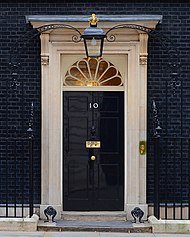
London is the seat of the Government of the United Kingdom. Many government departments, as well as the prime minister's residence at 10 Downing Street, are based close to the Palace of Westminster, particularly along Whitehall.[120] There are 73 members of Parliament (MPs) from London; As of December 2019[update], 49 are from the Labour Party, 21 are Conservatives, and three are Liberal Democrats.[121] The ministerial post of minister for London was created in 1994 and as of 2020 is held by Paul Scully.[122]
Policing and crime
Policing in Greater London, with the exception of the City of London, is provided by the Metropolitan Police ("The Met"), overseen by the mayor through the Mayor's Office for Policing and Crime (MOPAC).[123] The Met is also referred to as Scotland Yard after the location of its original headquarters in a road called Great Scotland Yard in Whitehall. The City of London has its own police force – the City of London Police.[124] First worn by Met police officers in 1863, the custodian helmet has been called a "cultural icon" and a "symbol of British law enforcement".[125] Introduced by the Met in 1929, the blue police telephone box (basis for the TARDIS in Doctor Who) was once a common sight throughout London and regional cities in the UK.[126]

The British Transport Police are responsible for police services on National Rail, London Underground, Docklands Light Railway and Tramlink services.[127] The Ministry of Defence Police is a special police force in London, which does not generally become involved with policing the general public.[128] The UK's domestic counter-intelligence service (MI5) is headquartered in Thames House on the north bank of the River Thames, and the foreign intelligence service (MI6) is headquartered in the SIS Building on the south bank.[129]
Crime rates vary widely across different areas of London. Crime figures are made available nationally at Local Authority and Ward level.[130] In 2015, there were 118 homicides, a 25.5% increase over 2014.[131] Recorded crime has been rising in London, notably violent crime and murder by stabbing and other means have risen. There were 50 murders from the start of 2018 to mid April 2018. Funding cuts to police in London are likely to have contributed to this, though other factors are involved.[132] However, homicide figures fell in 2022 with 109 recorded for the year, and the murder rate in London is much lower than other major cities around the world.[133]
Geography
Scope
London, also known as Greater London, is one of nine regions of England and the top subdivision covering most of the city's metropolis. The City of London at its core once comprised the whole settlement, but as its urban area grew, the Corporation of London resisted attempts to amalgamate the city with its suburbs, causing "London" to be defined several ways.[134]
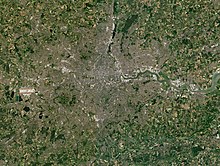
Forty per cent of Greater London is covered by the London post town, in which 'London' forms part of postal addresses.[135] The London telephone area code (020) covers a larger area, similar in size to Greater London, although some outer districts are excluded and some just outside included. The Greater London boundary has been aligned to the M25 motorway in places.[136]
Further urban expansion is now prevented by the Metropolitan Green Belt, although the built-up area extends beyond the boundary in places, producing a separately defined Greater London Urban Area. Beyond this is the vast London commuter belt.[137] Greater London is split for some purposes into Inner London and Outer London,[138] and by the River Thames into North and South, with an informal central London area. The coordinates of the nominal centre of London, traditionally the original Eleanor Cross at Charing Cross near the junction of Trafalgar Square and Whitehall, are about 51°30′26″N 00°07′39″W / 51.50722°N 0.12750°W.[139]
Status
Within London, both the City of London and the City of Westminster have city status and both the City of London and the remainder of Greater London are counties for the purposes of lieutenancies.[140] The area of Greater London includes areas that are part of the historic counties of Middlesex, Kent, Surrey, Essex and Hertfordshire.[141] London's status as the capital of England, and later the United Kingdom, has never been granted or confirmed by statute or in written form.[note 5]
Its status as a capital was established by constitutional convention, which means its status as de facto capital is a part of the UK's uncodified constitution. The capital of England was moved to London from Winchester as the Palace of Westminster developed in the 12th and 13th centuries to become the permanent location of the royal court, and thus the political capital of the nation.[144] More recently, Greater London has been defined as a region of England and in this context is known as London.[145]
Topography

Greater London encompasses a total area of 611 square miles (1,583 km2) an area which had a population of 7,172,036 in 2001 and a population density of 11,760 inhabitants per square mile (4,542/km2). The extended area known as the London Metropolitan Region or the London Metropolitan Agglomeration, comprises a total area of 3,236 square miles (8,382 km2) has a population of 13,709,000 and a population density of 3,900 inhabitants per square mile (1,510/km2).[146]
Modern London stands on the Thames, its primary geographical feature, a navigable river which crosses the city from the south-west to the east. The Thames Valley is a flood plain surrounded by gently rolling hills including Parliament Hill, Addington Hills, and Primrose Hill. Historically London grew up at the lowest bridging point on the Thames. The Thames was once a much broader, shallower river with extensive marshlands; at high tide, its shores reached five times their present width.[147]
Since the Victorian era the Thames has been extensively embanked, and many of its London tributaries now flow underground. The Thames is a tidal river, and London is vulnerable to flooding.[148] The threat has increased over time because of a slow but continuous rise in high water level caused by climate change and by the slow 'tilting' of the British Isles as a result of post-glacial rebound.[149]
Climate
London has a temperate oceanic climate (Köppen: Cfb). Rainfall records have been kept in the city since at least 1697, when records began at Kew. At Kew, the most rainfall in one month is 7.4 inches (189 mm) in November 1755 and the least is 0 inches (0 mm) in both December 1788 and July 1800. Mile End also had 0 inches (0 mm) in April 1893.[150] The wettest year on record is 1903, with a total fall of 38.1 inches (969 mm) and the driest is 1921, with a total fall of 12.1 inches (308 mm).[151] The average annual precipitation amounts to about 600 mm, which is half the annual rainfall of New York City.[152] Despite relatively low annual precipitation, London receives 109.6 rainy days on the 1.0 mm threshold annually. London is vulnerable to climate change, and there is concern among hydrological experts that households may run out of water before 2050.[153]
Temperature extremes in London range from 40.2 °C (104.4 °F) at Heathrow on 19 July 2022 down to −17.4 °C (0.7 °F) at Northolt on 13 December 1981.[154][155] Records for atmospheric pressure have been kept at London since 1692. The highest pressure ever reported is 1,049.8 millibars (31.00 inHg) on 20 January 2020.[156]
Summers are generally warm, sometimes hot. London's average July high is 23.5 °C (74.3 °F). On average each year, London experiences 31 days above 25 °C (77.0 °F) and 4.2 days above 30.0 °C (86.0 °F). During the 2003 European heat wave, prolonged heat led to hundreds of heat-related deaths.[157] A previous spell of 15 consecutive days above 32.2 °C (90.0 °F) in England in 1976 also caused many heat related deaths.[158] A previous temperature of 37.8 °C (100.0 °F) in August 1911 at the Greenwich station was later disregarded as non-standard.[159] Droughts can also, occasionally, be a problem, especially in summer, most recently in summer 2018, and with much drier than average conditions prevailing from May to December.[160] However, the most consecutive days without rain was 73 days in the spring of 1893.[161]
Winters are generally cool with little temperature variation. Heavy snow is rare but snow usually falls at least once each winter. Spring and autumn can be pleasant. As a large city, London has a considerable urban heat island effect,[162] making the centre of London at times 5 °C (9 °F) warmer than the suburbs and outskirts.[163]
| Month | Jan | Feb | Mar | Apr | May | Jun | Jul | Aug | Sep | Oct | Nov | Dec | Year |
|---|---|---|---|---|---|---|---|---|---|---|---|---|---|
| Record high °C (°F) | 17.2 (63.0) |
21.2 (70.2) |
24.5 (76.1) |
29.4 (84.9) |
32.8 (91.0) |
35.6 (96.1) |
40.2 (104.4) |
38.1 (100.6) |
35.0 (95.0) |
29.5 (85.1) |
21.1 (70.0) |
17.4 (63.3) |
40.2 (104.4) |
| Mean daily maximum °C (°F) | 8.4 (47.1) |
9.0 (48.2) |
11.7 (53.1) |
15.0 (59.0) |
18.4 (65.1) |
21.6 (70.9) |
23.9 (75.0) |
23.4 (74.1) |
20.2 (68.4) Zdroj:https://en.wikipedia.org?pojem=London,_England Text je dostupný za podmienok Creative Commons Attribution/Share-Alike License 3.0 Unported; prípadne za ďalších podmienok. Podrobnejšie informácie nájdete na stránke Podmienky použitia.
Analytika
Antropológia Aplikované vedy Bibliometria Dejiny vedy Encyklopédie Filozofia vedy Forenzné vedy Humanitné vedy Knižničná veda Kryogenika Kryptológia Kulturológia Literárna veda Medzidisciplinárne oblasti Metódy kvantitatívnej analýzy Metavedy Metodika Text je dostupný za podmienok Creative
Commons Attribution/Share-Alike License 3.0 Unported; prípadne za ďalších
podmienok. www.astronomia.sk | www.biologia.sk | www.botanika.sk | www.dejiny.sk | www.economy.sk | www.elektrotechnika.sk | www.estetika.sk | www.farmakologia.sk | www.filozofia.sk | Fyzika | www.futurologia.sk | www.genetika.sk | www.chemia.sk | www.lingvistika.sk | www.politologia.sk | www.psychologia.sk | www.sexuologia.sk | www.sociologia.sk | www.veda.sk I www.zoologia.sk | ||||

